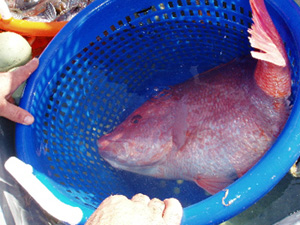|
 |
|
Daily
At-Sea Logs |
| Saturday, May 15, 2004 There is nothing better than waking from a good night’s sleep to enjoy the morning while being surrounded by blue water and clear skies. What a perfect morning to be in Gray’s Reef! George Sedberry's crew deployed three fish traps this morning at 0730 hours in the southeast region of the sanctuary. This is a little earlier than normal and we need to get a jump-start on today’s sampling because it will be a busy one. The agenda will be quite different from the others because Turner South Productions will be joining us for the next two days. We anticipate the arrival of the camera crew from Turner South to our location around 1000 hours. They will interview the scientists and crew, as well as film our operations here in Gray’s Reef. The video footage will be part of a production that will be aired on The Natural South television show in July or August. Throughout the week, the scientists have been rehearsing how they might respond to the interviewer’s battery of questions about their research. Since this program will be aired for public viewing, it is important that our research here in the sanctuary is described in a way that the general public can understand; this is not as easy as it may sound. The veteran scientists aboard this ship have many years of experience in fisheries science, which can be hard to translate into everyday vocabulary that the general public will understand. Over breakfast this morning, Grant Gilmore shared with me the disappointing news about his hydrophone and PAMS instruments. It seems as if all three of his PAMS instruments shutdown prematurely before collecting data after deployment to the ocean floor. When I spoke to Glenn, the ROV technician and diver, he was disheartened about the news. He dove down with the PAMS units to make sure that they were safe; during this time, he saw a school of sheep’s head fish next to the PAMS. These are precisely the kinds of action that Grant is hoping to collect with his acoustic instruments and recorders. To make matters worse, Grant’s hydrophone has also been damaged and does not work properly. He suspects that the fragile instrument hit the ship during the deployment phase. It
is now time to retrieve the fish traps. Unfortunately, as we pulled
the first trap from the seafloor, the wire snapped so our divers must
swim to the trap and reattach the buoy. Good thing we have Global
Positioning Satellite (GPS) system technology on the boat; this tool
tracks the ship’s latitude and longitude, and helps us pinpoint
the position of the lost trap. With the help of our divers, we’re
hopeful that the trap will be located. Sure enough, Dave and Glenn
located the trap, and we will pull it up after we retrieve the second
and third Just
moments ago, during the retrieval of the second fish trap, we The boat transporting the production crew has finally met up with the Nancy Foster. Once they’ve unloaded their gear, they will get straight to work with their interviewing and filming agenda. By the looks on their faces, each member of the production staff seemed as awestruck as I was on my first day in Gray’s Reef. It is wonderful that our research here at Gray’s Reef will reach the masses. Hopefully, viewers will glean much about the ecosystem and fisheries resources here off Georgia’s coast, as I have. It is time for me to join the rest of my group in the Mess Hall for a bite to eat for dinner. I hope you will visit tomorrow for accounts of our exploration of the sanctuary. Signing
off,
|
|||||||||


 pulled up a 70 cm long red snapper.(picture
on right) What a whopper! Along with the snapper we collected,
you guessed it, more black sea bass. Let’s see what the next
trap will bring. Boy, this catch is a bit different from the others;
we caught a flounder, sand perch, shark suckers, scup, and believe
it or not, we did not catch any sea bass this time. Perhaps the absence
of the bass may have something to do with the sandy bottom habitat
below.
pulled up a 70 cm long red snapper.(picture
on right) What a whopper! Along with the snapper we collected,
you guessed it, more black sea bass. Let’s see what the next
trap will bring. Boy, this catch is a bit different from the others;
we caught a flounder, sand perch, shark suckers, scup, and believe
it or not, we did not catch any sea bass this time. Perhaps the absence
of the bass may have something to do with the sandy bottom habitat
below.